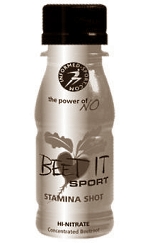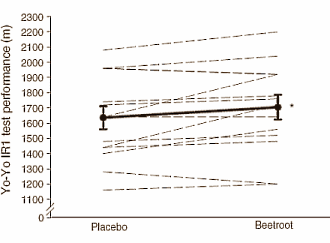|
Definition: "An ergogenic aid is any substance or phenomenon that enhances performance "
|
|
||||||||
05.11.2013 |
|
|
Beetroot concentrate makes team sport players faster
It probably doesn't matter whether you play hockey, football, rugby or volleyball. According to the human study published by sports scientist at the University of Exeter in the European Journal of Applied Physiology, all team sports players perform better if they use concentrated beetroot juice. This nitrate-containing product makes them significantly faster.
Beetroot, nitrate & sports performance
The most popular nitrate-rich extracts in the sports world right now are made from Beta vulgaris - beetroot to most of us. Beetroot extracts have become so popular among endurance athletes that doping hunters are regularly confronted with red urine samples.
Study
The researchers used Beet It, produced by James White Drinks. On the day before the experiment 14 male recreational team sports players drank 140 ml of the stuff in the morning and the same amount again in the evening. On the day of the experiment they drank 140 ml 2.5 hours before the test, and one hour later they drank another 70 ml.
The researchers repeated the procedure with a placebo.
The researchers got the subjects to perform the Yo-Yo Intermittent Recovery Test. This involves running a distance of 40 m in less and less time. Between the spurts the subjects were allowed to rest for 10 seconds. The test stops when the subjects can no longer manage to run the 40 m in the allowed time.
Results
Before starting the Yo-yo Intermittent Recovery Test, the researchers got their subjects to do some non-intensive exercise [Sub. IR1]. At this point the beetroot supplementation [black circles in the graph below] had no statistically significant effect on the glucose level.
During the Yo-Yo Intermittent Recovery Test the effect was statistically significant: the glucose level was significantly lower in the subjects who had had the beetroot extract. It seems that beetroot helps the muscles to absorb more glucose during intensive exercise.
Conclusion
Source:
More:
|
|



